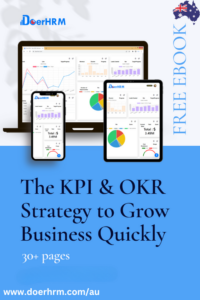Measuring employee performance is an essential part of assessing your business’ health. Since your people are your biggest asset, you need to ensure everyone is meeting their full potential, with access to the right support and opportunities. Key performance indicators provide teams with useful metrics to try and benchmark progress. We’ve put together some of the best universal KPIs businesses can use to quickly check high-level employee productivity and effectiveness.
To learn how OKRs can help take your team to the next level, enroll in our OKR Mastery course and earn a 35% commission when you invite others to join this course!
Why Should You Use KPIs To Track Employee Performance?
You may be wondering why you should use KPIs to track employee performance when you can base your employees’ performance on traditional metrics instead. A common mistake made by business leaders is only measuring their employees numerically instead of looking at the bigger picture. KPIs offer valuable insights that other metrics do not.
KPIs allow managers to look at both qualitative and quantitative data when assigning KPIs to their team. This is a great tool to see the strengths and weaknesses of each employee and allow you to understand their motivation triggers, making you a better manager and ultimately adding value to your operations. You may even identify new opportunities for growth for your business!
Using KPIs to track employee performance is a great way to create clear goals and objectives for your employees and help track their progress. It allows businesses to identify the strengths and weaknesses of each of their employees and provides valuable business lessons throughout the year. But how can you implement KPIs at your company and what are the KPIs for employee performance samples? Keep reading on to find out more and also the KPI for employee performance samples which are provided at the end of this article.
Now, we have one more thing to talk about before we go into the KPI for employee performance samples. What we are going to talk about before the KPI for employee performance samples is what employees think about KPIs as it is also very important to know employees’ opinions on KPIs.
What Do Employees Think About KPIs For Employee Performance?
While KPIs act as a great employee evaluation tool for businesses do employees like them as well? The short answer is – yes! KPIs are a great way to incentivise staff members to perform through bonuses and awards.
Make no mistake—KPIs should not be used in isolation to assess the individual value or contribution of your employees. Performance appraisals depend on a broad application of qualitative and quantitative feedback, which don’t just focus on productivity. Your employees’ worth cannot be reduced down to a number, and that is not the purpose of using KPIs.
These KPIs allow employees to keep track of their overall progress so there are no hidden surprises when their performance review rolls around. If employees aren’t meeting their KPIs for whatever reason, they can discuss this further with their line manager. It may be the case that the employee has been assigned too much work or has been given tasks they don’t excel at.
KPIs don’t have to be scary – you can choose to review the ones you set as often as you like! People generally like transparency in the workplace and KPIs allow for business goals and objectives to be as transparent as possible.
Samples Of KPIs For Employee Performance

While it’s all well and good learning about KPIs, how do you implement them at your business? Fear not – here are some great KPIs for employee performance samples.
Revenue per employee – This is the most basic indicator of what each employee contributes. It is useful for ensuring your profitability, since a high measure indicates a large amount of revenue brought in, and vice versa.
Profit per employee – Similar to the above, this employee performance KPI breaks down raw profitability (free from expenses), which may be useful for companies with remote or freelance workers who don’t incur the same expenses as in-house employees.
Utilization rate – This KPI shows you the overall ratio of directly profitable work to internal cost each employee engages in. Different companies have very different stances on the value relationship between “billable” and “non-billable” time, and we’re of the opinion they are equally important. However you view it, you need to see how much time your team spends on non-billable time to be able to price and plan work competitively.
Average task completion rate – Again, this should be taken as a rough guide to inform the overall efficiency of your team. It’s useful for understanding how long different phases of a project usually take your employees, so you can improve budget estimates and resource management.
Overtime per employee – The average overtime metric can be interpreted in a whole of different ways. Some companies use it to understand the health of their employees—both in terms of engagement and physical wellbeing. But it shouldn’t be taken as an indicator of employee dedication, since “presenteeism” alone doesn’t translate to “quality of work” or “enthusiasm”. If your staff are constantly performing overtime, you might actually need to increase your workforce. In the interests of your company culture—whether you embrace or reject overtime—it’s a good idea to keep an eye on it.
Well, that is all about the KPI for employee performance samples. Do you have a clearer view of KPIs after reading these KPIs for employee performance samples? Hope these KPIs for employee performance samples can motivate you to implement them in your business.
Implement KPIs to Track Employee Performance Today
The great thing about KPIs is that you can modify them throughout the year – after all, they exist to help companies learn what they need to do differently and to identify opportunities.
Many companies work across complex Excel sheets to get the figures to track these employee KPIs. But solutions do exist to track them for you in the background.
KPI solution like DoerHRM can track all of the figures needed to work out the above KPIs while you work. Try assigning your employees KPIs to track their performance today – you won’t regret it!









